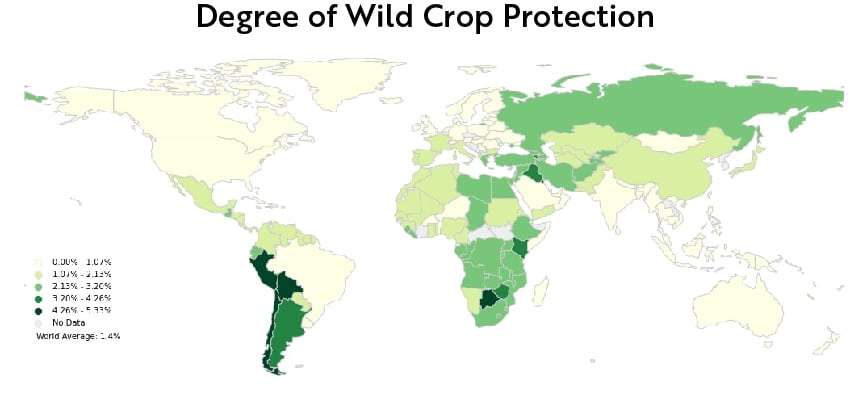Since the Green Revolution, an emphasis on cropland productivity has overtaken time-proven traditional practices that actually played an important role in the sustainability of farming. It has also shifted the landscape toward heavy monoculture instead of a healthy mix of wild crops, threatening food security by its “all eggs in one basket” nature.
Earth.Org takes a closer look.
—
Cross-breeding between cultivated crops and their indigenous close relatives growing in the wild can help build a resilient food supply chain. Expanding the gene pool of the current food system is a practical strategy to produce crops with higher resilience to adverse weather conditions and pathogens especially. Unfortunately, wild plants and their gene pool are endangered due to habitat loss and insufficient protection.
Colin Khoury, a leading researcher in agrobiodiversity, conducted a survey to measure the percentage of adequately protected useful wild crops (see figure below). The results are concerning: not a single region scored in double-digits, with the global average standing at a mere 1.4%.

Source: Data Source: Food System Dashboard
Countries practicing intensive industrial farming performed the worst in this study. India, which experienced the Green Revolution in the 1960s performed on par with the US, Canada, Brazil, and Australia. On the contrary, Sub-Saharan African and South America are, on average, better at preserving and protecting useful wild crops.
This pattern reflects a crucial vulnerability of the new, industrialized food supply chain: the monoculture of only 25% of the strains grown in the past 10,000 years. Cultivated crops are becoming more susceptible to adverse climatic conditions, but importantly, to pathogens. This is because uniform genetic makeup means that the entire population is exposed when the right (or wrong) pathogen comes up.
One prominent direction of solution revolves around the integration of wild plants into the food supply chain. A team at Queensland University of Technology are now developing a new banana strain using genes from wild varieties. Although the project is still under way, the preliminary result was promising. A similar project is also being conducted by the International Center for Tropical Agriculture, breeding a new strain of bean derived from the wild tepary beans that can cope with the increasing heat stress.
The protection of the natural environment not only constitutes climate action, but also an initiative to protect our food system. Preserving the natural state of the environment allows important wild crops to thrive and be introduced into the future food system. Better yet, agricultural businesses should respect the natural system and conform with indigenous environment. Such a reinvention of food production would maybe drop yields for a while until the methods were scaled up and optimized. In the meantime, let’s remember that 30% of all food is lost, and that there is well enough to feed everyone. Pushing productivity while sacrificing the long-term is not the way to go.
This article was written by Travis Yip. Cover photo by Amy Humphries on Unsplash
You might also like: Emissions in a Post-COVID-19 World










![The Statistics of Biodiversity Loss [2020 WWF Report]](https://u4d2z7k9.rocketcdn.me/wp-content/uploads/2020/12/lprwinkyTHB-544x306.jpg)





